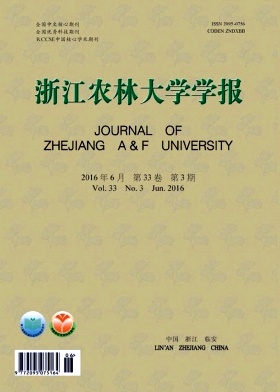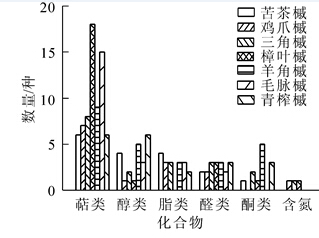-
植物通过次生代谢释放的挥发性有机化合物(volatile organic compounds,VOCs)主要包括萜烯类、苯丙酸类/苯环型和脂肪酸衍生物[1-2]。这些VOCs是植物生长[3]、发育[4]和繁衍[5]以及抵抗不利条件[6-8]的重要手段,在人居环境中影响空气质量[9]和人体健康[10-12]。随着核磁共振和色谱等分析技术的发展,对园林树木释放VOCs的研究逐渐增多。目前,国内研究集中在油松Pinus tabuliformis,侧柏Platycladus orientalis等针叶树上[11, 13],而对阔叶树较缺乏系统研究。槭树Acer spp.隶属槭树科Aceraceae槭树属Acer阔叶乔木或灌木,主产于北温带地区,是温带落叶阔叶林、针阔混交林以及亚热带山地森林的建群种和重要组成,也是针叶林的伴生种,中国槭树种类世界最多,许多槭树为优良荒山绿化和园林造景树种[14]。糖槭A.saccharum,五角枫A.mono,元宝枫A.truncatum,复叶槭A.negundo和挪威槭A.platanoides等释放的VOCs具有信号传导[15]、抑制昆虫[16-17]和真菌[18]的作用,关于其他槭树释放VOCs尚未见报道。因此,本研究以槭树为试验材料,采用活体植株动态顶空气体循环采集法与热脱附/气相色谱/质谱(TDS-GC-MS)联用技术测定不同槭树释放VOCs,旨在探索槭树释放VOCs组分与规律,为进一步研究植物VOCs对环境质量的影响以及植物配置提供依据。
HTML
-
以浙江农林大学东湖校区7种不同槭树苦茶槭Acer ginnala,鸡爪槭A.palmatum,三角槭A.buergerianum,樟叶槭A.cinnamomifolium,羊角槭A.yangjuechi,毛脉槭A.pubinerve和青榨槭A.davidii为材料。采集健康无损伤,树龄15 a左右植株枝叶释放VOCs。
-
于2013年7月10-20日上午10:00-11:00,采用动态顶空气体循环法[11]采集7种槭树枝叶释放VOCs。选择生长一致的叶片,采集叶片40片·次-1,3次重复。采气袋容积为0.1 m3,采气时间30 min,气体流量0.1 m3·min-1。
-
VOCs分析采用TDS-GC-MS联用技术,仪器及参数设置条件参考文献[11]。TDS(德国GERSTEL公司TD3型)工作条件:系统载气压力20 kPa,进样口温度250 ℃,脱附温度250 ℃,10 min,冷阱温度-100 ℃,保持3 min,冷阱进样时温度骤然升至260 ℃。GC(7890A,Agilent安捷伦科技有限公司)工作条件:色谱柱为30.00 m×250.00 μm×0.25 μm的HP-5 MS柱;程序升温;初始温度40 ℃,4 min后以6 ℃·min-1的速率升至250 ℃,保持3 min后以10 ℃·min-1的速率升至270 ℃,保持5 min。MS(5975C,Agilent安捷伦科技有限公司)工作条件:电离方式为EI,电子能量为70 eV,质量范围为4.67×10-27~75.02×10-27,接口温度280 ℃,离子源温度230 ℃,四级杆温度150 ℃。
-
采用NIST 2008谱图库兼顾色谱保留时间,同时结合手工检索确定VOCs成分,利用峰面积归一化法测定各组分的百分含量,数据处理采用Origin 8软件。
1.1. 材料
1.2. VOCs采集
1.3. VOCs分析
1.4. 数据处理
-
槭树科7种植物释放的VOCs通过TDS-GC-MS分析(图 1),扣除本底空气中的杂质后,共鉴定出48种化合物(表 1)。其中苦茶槭鉴定出17种化合物,主要是酯类、醛类和醇类,包括乙酸叶醇酯(63.0%),癸醛(6.5%)和2-乙基-1-己醇(5.6%)等10种化合物,占VOCs总量的89.7%;鸡爪槭检测出15种化合物,主要是酯类、萜类和醇类,包括乙酸叶醇酯(49.6%),长叶烯(9.7%),2-乙基-1-己醇(11.7%)等11种化合物,占VOCs总量的85.5%;三角槭检测出19种化合物,主要是萜类、醛类和酯类,包括罗勒烯(20.3%),长叶烯(10.6%),乙酸叶醇酯(13.0%),癸醛(11.3%)和壬醛(9.2%)等14种化合物,占VOCs总量的84.9%;樟叶槭检测出24种化合物,主要为罗勒烯(24.4%),α-蒎烯(15.6%)和3-蒈烯(11.9%)等18种萜类化合物,占VOCs总量的96.6%;羊角槭检测出25种化合物,主要是萜类、醛类和醇类,包括长叶烯(12.0%),石竹烯(10.1%),癸醛(14.9%),壬醛(8.6%)和2-乙基-1-己醇(11.8%)等17种化合物,占VOCs总量的81.1%;毛脉槭检测出23种化合物,主要为萜类和酯类,包括罗勒烯(11.4%),长叶烯(8.9%)和乙酸叶醇酯(18.3%)等18种化合物,占VOCs总量的79.0%;青榨槭检测出20种化合物,主要是醇类、酯类和醛类,包括乙酸叶醇酯(23.7%),癸醛(15.0%),壬醛(10.1%),(Z)-3-己烯-1-醇(11.1%)和2-乙基-1-己醇(7.7%)等11种化合物,占VOCs总量的80.9%。

Figure 1. Total ion current of volatile organic compounds released from branches and leaves in 7 Acer species
挥发性有机化合物 分子式 峰面积Ax106 苦茶槭 鸡爪槭 三角槭 樟叶槭 羊角槭 毛脉槭 青榨槭 萜类 3-蒈烯 3-garene C10H16 - - - 330.39 ± 0.05 3.42 ± 0.03 - - α-蒎烯 α-pinene C10H16 2.90 ± 0.12 1.80 ± 0.37 1.08 ± 2.15 433.87 ± 4.32 9.67 ± 1.01 3.17 ± 0.31 3.03 ± 1.76 β-蒎烯 β-pinene C10H16 - - - 299.27 ± 1.18 14.72 ± 0.01 9.88 ± 0.19 - 罗勒烯 ocimene C10H16 - 2.36 ± 0.97 32.55 ± 0.02 679.70 ± 1.64 2.88 ± 0.25 26.91 ± 0.89 - 反式罗勒烯 trans-ocimene C10H16 - - - 102.86 ± 1.21 - 2.57 ± 0.01 - 别罗勒烯 Allo-ocimene C10H16 - - - 39.87 ± 2.54 - - - D-柠檬烯 D-limonene C10H16 - - - 20.36 ± 0.23 - 7.36 ± 2.34 14.49 ± 2.67 松油烯terpinene C10H16 - - - 257.16 ± 9.18 - - - 焦烯 pyronene C10H16 - - - 91.93 ± 8.49 6.83 ± 0.15 - - 环葑烯 cyclofenchene C10H16 - - - 217.38 ± 6.37 - - - 萜品油烯terpinolene C10H16 - - - 147.15 ± 9.81 - - - 香芹醇carveol C10H16O 2.07 ± 0.01 - - 9.22 ± 0.12 - 13.80 ± 0.84 - 1,4-按树脑 1,4-cineole C10H18O - - - 11.15 ± 1.67 - - - 萜品醇terpineol C10H16O - - - 4.24 ± 5.02 - - - 卡达烯cadalene C15H18 - - - - - 4.66 ± 0.24 - 罗汉柏烯thujopsene C15H24 - 1.84 ± 0.99 - - - - - 长叶环烯longicyclene C15H24 2.16 ± 0.69 2.83 ± 1.00 4.63 ± 2.17 4.37 ± 0.34 6.99 ± 1.27 3.26 ± 0.04 3.20 ± 0.56 长叶烯 longifolene C15H24 6.77 ± 2.52 13.74 ± 2.35 17.04 ± 1.16 21.40 ± 2.02 44.23 ± 5.64 21.13 ± 2.70 15.09 ± 0.02 雪松烯cedrene C15H24 2.41 ± 1.33 3.01 ± 0.18 3.81 ± 0.46 4.92 ± 1.10 9.00 ± 1.26 5.25 ± 0.43 3.02 ± 2.39 石竹烯 caryophyllene C15H24 1.95 ± 0.90 2.87 ± 0.45 8.97 ± 3.00 15.99 ± 1.80 37.01 ± 2.01 10.09 ± 1.08 3.65 ± 1.22 可巴烯 copaene C15H24 - - 3.50 ± 0.42 - - 4.12 ± 0.58 - 荜澄茄烯 cadinene C15H24 - - 2.47 ± 0.06 - - 12.71 ± 0.11 - 衣兰油烯 muurolene C15H24 - - - - - 2.71 ± 0.13 - 法尼醇 farnesol C15H26O - - - - - 2.46 ± 0.60 - 醇类 (Z)-3-己烯-1-醇 3-hexen- 1- ol,(Z)- C16H12O - - - - - - 32.73 ± 1.48 2- 乙基-1-己醇 1-hexanol,2-ethyl - C8H18O 11.84 ± 0.21 16.55 ± 0.50 10.74 ± 5.32 43.21 ± 0.02 18.94 ± 0.61 22.65 ± 6.54 (E)-2-壬烯-1-醇 2-nonen- 1-ol,(E)- C9H180 - - - - 3.50 ± 0.43 - 3.15 ± 0.49 3,7-二甲基-1-辛醇1- octano, 3,7-dimethyl- C10H22O 5.10 ± 0.04 2.17 ± 0.15 2.64 ± 0.17 3.00 ± 3.56 7.65 ± 0.03 1-癸醇 1-decanol C10H22O 2.95 ± 0.07 - - - 4.84 ± 0.20 - 3.81 ± 0.01 反式-2-十二烯-1-醇trans- 2-dodecen-1-ol C12H24O 3.51 ± 2.16 1.65 ± 0.67 5.74 ± 0.99 9.82 ± 0.06 16.83 ± 1.23 4.84 ± 0.50 10.03 ± 0.95 酯类 甲酸乙酷formic acid,vinyl ester C3H4O2 4.23 ± 0.33 2.55 ± 0.02 - - - - - 乙酸叶醇酯 3-hexen-1-ol,acetate C8H14O2 133.57 ± 5.66 70.21 ± 8.89 20.91 ± 1.29 15.37 ± 7.61 43.37 ± 5.40 69.83 ± 4.12 乙酸己酯 acetic acid,hexyl ester C8H16O2 2.67 ± 0.25 2.12 ± 0.03 2.65 ± 0.11 水杨酸甲酯 methyl salicylate C8H8O3 - - 3.39 ± 0.06 - - - - 异丁酸叶醇酯hexenyl isobutanoate C10H18O2 - - 2.92 ± 1.83 - - - - 醋酸-2-乙基己酯acetic acid, 2-ethylhexyl ester C10H20O2 2.68 ± 0.09 - - - 15.70 ± 0.33 11.05 ± 1.21 10.06 ± 0.16 乙酸龙脑酯bornyl acetate C12H20O2 - - - - 4.10 ± 1.00 - - 醛类 2.4- 己二烯醛 2.4- hexadienal C6H8O - - - - - - 4.62 ± 0.11 壬醛 nonanal >C9H18O 10.04 ± 1.17 7.53 ± 1.94 14.74 ± 3.25 32.67 ± 2.58 31.49 ± 3.41 11.03 ± 2.75 29.63 ± 3.06 枯茗醛 cuminaldehyde >C10H20O - - - 3.98 ± 0.05 - - - 癸醛 decanal C10H20O 13.76 ± 1.35 6.00 ± 1.79 18.18 ± 2.31 27.37 ± 6.00 54.87 ± 5.14 12.03± 3.77 44.24 ± 8.00 十—醛 undecanal 酮类 C11H22O - - 2.15 ± 0.34 - 5.88 ± 2.75 - - 酮类 乙醜苯 acetophenone C8H8O - - - - 3.67 ± 1.22 - - 异佛尔酮 isophorone C9H14O - - 2.12 ± 0.03 12.93 ± 0.10 6.45 ± 0.21 香叶基丙酮 acetone, Geranyl-烃类 C13H22O - - 2.00 ± 0.72 8.55 ± 0.51 9.69 ± 0.01 - 3.04 ± 0.98 烃类 1-十二烯 1-dodecene C12H24 3.31 ± 0.15 - - - 3.36 ± 0.32 - 4.42 ± 0.41 2,6,10-三甲基-十四烯 tetradecane,2,6,10-trimethyl- C17H36 - - - - 4.38 ± 0.81 - - 含氮类 己内酰胺caprolactam C6H11NO - 4.38 ± 1.27 3.55 ± 1.30 13.75 ± 1.01 说明:-表示未检出。 Table 1. Main components of the volatile organic compounds released from branches and leaves in 7 Acer species (mean ± SD)
槭树科7种植物释放VOCs的共有成分是α-蒎烯、长叶烯、长叶环烯、雪松烯、石竹烯、反式-2-十二烯-1-醇、壬醛和癸醛等8种化合物,分别占苦茶槭、鸡爪槭、三角槭、樟叶槭、羊角槭、毛脉槭和青榨槭各总量的20.5%,26.7%,46.2%,19.8%,57.2%,29.9%和38.0%。常绿树樟叶槭与落叶树苦茶槭、鸡爪槭、三角槭、羊角槭、毛脉槭和青榨槭共有成分分别为21.5%,32.6%,70.0%,67.4%,55.4%和43.9%。特有成分最多的是樟叶槭(24.4%),其次是青榨槭(12.7%)、毛脉槭(4.2%)、三角槭(3.9%)、羊角槭(3.3%)和鸡爪槭(1.3%)。
-
7种槭树科植物释放VOCs种类和相对含量存在显著差异(图 2)。苦茶槭共有5类化合物,萜类6种(8.6%),醇类4种(11.0%),酯类4种(67.6%),醛类2种(11.2),烃类1种(1.6%);鸡爪槭含有萜类、烃类、醛类等5类化合物,萜类7种(20.1%),醇类1种(11.9%),酯类3种(52.9%),醛类2种(9.6%),含氮化合物1种(3.1%);三角槭包括萜类、酮类、醛类等6类化合物:萜类8种(46.1%),醇类2种(10.3%),酯类3种(17.0%),醛类3种(21.9%),酮类2种(2.6%),含氮化合物1种(2.2%);樟叶槭含有萜类、醇类、醛类等5类化合物:萜类18种(96.6%),醇类1种(0.4%),醛类3种(2.3%),酮类1种(0.3%),含氮化合物1种(0.5%);羊角槭含有萜类、醇类、酯类等6类化合物,萜类9种(36.7%),醇类5种(19.3%),酯类3种(9.6%),醛类3种(25.1%),酮类3种(7.2%),烃类2种(2.1%);毛脉槭含有萜类、醇类、酯类等4类化合物,萜类15种(54.9%),醇类3种(11.3%),酯类3种(24.1%),醛类2种(9.7%);青榨槭含有萜类、醇类、脂类等6类化合物,萜类6种(14.4%),醇类6种(27.2%),酯类2种(27.1%),醛类3种(26.6%),酮类2种(3.2%),烃类1种(1.5%)。萜类化合物含量最高的是樟叶槭,其相对含量分别是苦茶槭、鸡爪槭、三角槭、羊角槭、毛脉槭和青榨槭的14.6倍、4.8倍、2.1倍、2.6倍、2.8倍和6.7倍。在苦茶槭VOCs中脂类化合物相对含量最高,其相对含量是鸡爪槭、三角槭、羊角槭、毛脉槭和青榨槭的1.3倍、4.0倍、7.1倍、2.8倍和2.5倍,在樟叶槭中未检测到。
2.1. 槭树科7种植物释放VOCs成分分析
2.2. 槭树科7种植物释放VOCs种类及差异性比较
-
本研究对华东地区生长的7种槭树释放VOCs研究表明:同属不同种间植物释放VOCs种类和相对含量差异明显。常绿树樟叶槭与落叶类释放VOCs差异较大,说明槭树中常绿类与落叶类释放VOCs差异可能不完全反应组系差异。落叶类槭树间释放VOCs差异较小,共有成分较高(占63.0%~96.0%),其中鸡爪槭在落叶类中共有成分最高(占91.0%~94.0%),可能为所测落叶类槭树释放VOCs的核心类型。本研究中苦茶槭和鸡爪槭主要成分是酯类物质(50.0%以上),与张风娟等[16]测定华北地区生长的4种落叶类槭树释放成分一致;羊角槭释放的α-蒎烯、β-蒎烯、乙酸叶醇酯、长叶烯、长叶环烯和石竹烯等物质,在宋秀华等[19]测试的元宝枫7月释放VOCs中也检测到。这可能与采集方法、发育节律[19]、外界条件[20]、生长地域及亲缘关系等因素有关,槭树释放VOCs调控规律还需深入研究。
萜类化合物在药剂预防和治疗心血管疾病、癌症以及抗菌、抗炎、抗病毒、抗氧化剂、抗高血糖等生物活性方面扮演着一定角色[21]。石竹烯具有镇静、抗焦虑、抗抑郁[22],抗炎[22]和抗肿瘤活性[23];α-蒎烯[24]、3-蒈稀[25]、β-蒎烯[26]能抗炎镇痛;罗勒烯是重要信号分子,抗菌杀虫[27],抗白血病肿瘤细胞增殖[28];萜品油烯能有效抑制低密度脂蛋白氧化[29]。槭树均释放α-蒎烯、石竹烯等萜类物质,樟叶槭富含罗勒烯、α-蒎烯、3-蒈烯、β-蒎烯和萜品油烯,三角槭和毛脉槭主要释放罗勒烯,羊角槭主要释放石竹烯,推测所测槭树有不同程度的保健功能,可作为保健型园林植物材料。苦茶槭和鸡爪槭富含的乙酸叶醇酯(63.1%,49.6%)是一种具有香蕉气味的高级香料,推测其还可种植提取香精。萜类及C6~C10醇醛类物质对细菌、真菌和放线菌有抑制作用[11, 18, 21],说明槭树具有良好杀菌价值。建议在公园或小区的林荫步道、锻炼区、保健区等活动场所适量配置槭树,以抑制微生物、改善空气质量、预防疾病,发挥槭树资源优势,构建优美人居环境。












 DownLoad:
DownLoad:

